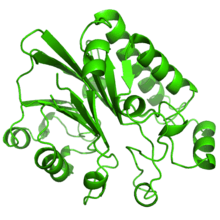Exonuclease III
| Exonuclease III | |
|---|---|
 | |
| Identifiers | |
| Organism | |
| Symbol | xthA |
| Alt. symbols | ExoIII |
| Entrez | 946254 |
| RefSeq (Prot) | NP_416263 |
| UniProt | P09030 |
| Other data | |
| EC number | 3.1.11.2 |
| Chromosome | genome: 1.83 - 1.83 Mb |
Exonuclease III (ExoIII) is an enzyme that belongs to the exonuclease family. ExoIII catalyzes the stepwise removal of mononucleotides from 3´-hydroxyl termini of double-stranded DNA.[1] A limited number of nucleotides are removed during each binding event, resulting in coordinated progressive deletions within the population of DNA molecules.[2]
Function
The preferred substrates are blunt or recessed 3´-termini, although ExoIII also acts at nicks in duplex DNA to produce single-strand gaps. The enzyme is not active on single-stranded DNA, and thus 3´-protruding termini are resistant to cleavage. The degree of resistance depends on the length of the extension, with extensions 4 bases or longer being essentially resistant to cleavage. This property is used to produce unidirectional deletions from a linear molecule with one resistant (3´-overhang) and one susceptible (blunt or 5´-overhang) terminus.[3]
ExoIII activity depends partially on the DNA helical structure [4] and displays sequence dependence (C>A=T>G).[5]
ExoIII has also been reported to have RNase H, 3´-phosphatase and AP-endonuclease activities.[1]
Regulation
Temperature, salt concentration and the ratio of enzyme to DNA greatly affect enzyme activity, requiring reaction conditions to be tailored to specific applications.
References
- 1 2 3 PDB: 1ako; Mol CD, Kuo CF, Thayer MM, Cunningham RP, Tainer JA (March 1995). "Structure and function of the multifunctional DNA-repair enzyme exonuclease III". Nature. 374 (6520): 381–6. doi:10.1038/374381a0. PMID 7885481.
- 1 2 Image rendered in MacPyMOL©2006 DeLano Scientific
- ↑ Rogers SG, Weiss B (1980). "Exonuclease III of Escherichia coli K-12, an AP endonuclease". Meth. Enzymol. Methods in Enzymology. 65 (1): 201–11. doi:10.1016/S0076-6879(80)65028-9. ISBN 978-0-12-181965-1. PMID 6246343.
- ↑ Maniatis, Tom; Sambrook, Joseph; Fritsch, E. F. (1989). Molecular cloning: a laboratory manual (2nd ed.). Cold Spring Harbor, N.Y: Cold Spring Harbor Laboratory. pp. 5.84–5. ISBN 0-87969-309-6.
- ↑ Henikoff S (June 1984). "Unidirectional digestion with exonuclease III creates targeted breakpoints for DNA sequencing". Gene. 28 (3): 351–9. doi:10.1016/0378-1119(84)90153-7. PMID 6235151.
Further reading
- Richardson CC, Lehman IR, Kornberg A (January 1964). "A Deoxyribonucleic Acid Phosphatase-Exonuclease from Escherichia coli. II. Characterization of the Exonuclease activity" (PDF). J. Biol. Chem. 239 (1): 251–8. PMID 14114851.
- Linxweiler W, Hörz W (August 1982). "Sequence specificity of exonuclease III from E. coli". Nucleic Acids Res. 10 (16): 4845–59. doi:10.1093/nar/10.16.4845. PMC 320823
 . PMID 6752885.
. PMID 6752885.